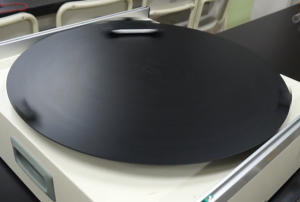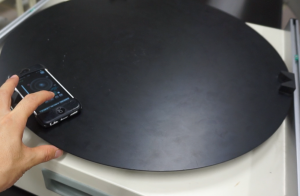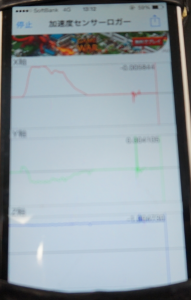Your Pocket Lab: Unlocking Physics Secrets with the Smartphone Sensors You Already Own
I’m Ken Kuwako, your Science Trainer. Every Day is an Experiment.
Did you know that the smartphone in your pocket is actually a miniature “science lab”? Whether it’s moving a character in a game or showing you which way is North on a map app, all of this is possible thanks to the high-performance sensors built into your phone. The “accelerometer” and “gyroscope” sense tilt and motion, and the “magnetic sensor” determines direction. These work together, allowing your phone to constantly know its “current state.”
There’s no way we shouldn’t use this for experiments!
Peeking into the Smartphone’s “Senses”
The app we’re introducing today, “Accelerometer, Gyroscope, and Magnetic Sensor Logger”—a bit of a mouthful—allows you to listen to these sensors’ “voices.”  This app is super easy to use. Just download it and press the “Start” button in the top left corner.
This app is super easy to use. Just download it and press the “Start” button in the top left corner.
With the app running, if you shake your iPhone sideways (x-axis), up and down (y-axis), or back and forth (z-axis), the graph for the three axes (x, y, and z) will move in real-time, capturing the instantaneous “acceleration (change in motion).” It’s fascinating to see your own movements instantly turned into data!
Challenge! Free-Fall Experiment with a Smartphone
This certainly sparks some ideas! First, we tried the classic “free-fall” experiment from your physics textbook. You drop the iPhone from a height and catch it just before it hits the ground!
(※ DO NOT try this! Your phone might break! This is especially not an experiment we can let students attempt.)
In physics textbooks, you learn that the acceleration due to gravity is approximately $9.8\, m/s^2$. However, when we actually tried it, the reading didn’t quite hit that number. This is likely related to the phone spinning as it falls, air resistance, and the time resolution of the sensor. While this experiment wasn’t suitable for precise numerical measurement, it gave us very interesting results for roughly observing when the acceleration changes dramatically (for example, the shock when you catch it!).
The Science Recipe: Unlocking Physics Laws with Your Phone
Here are two successful “at-home experiments” we came up with through trial and error.
What you need:
- iPhone (with the Accelerometer Sensor App)
- iPhone Case (a cheap one from a dollar store is fine)
- Awl (to make a hole. Use this with an adult)
- String/Cord
Procedure:
- Use the awl to punch a hole in the iPhone case and thread the string through it.
- Attach the case to the iPhone to create a pendulum.
- Start the accelerometer sensor and swing the pendulum (attaching it to a stand or pole helps it swing cleanly).
- Observe the data (you can also export the data as text for analysis in Excel).
Observation and Discovery:
When you perform this experiment, you can clearly see that the acceleration forms a sinusoidal curve (a sine wave).This is a crucial characteristic of the motion known in physics as “Simple Harmonic Motion.” When the pendulum reaches its maximum displacement (the turning point), the force pulling it back to the center is at its maximum, and thus the acceleration is also maximum. Conversely, when the pendulum passes directly below the pivot (its fastest point), the force momentarily becomes zero, and the acceleration is also zero. This repeating change in force—”Maximum $\rightarrow$ Zero $\rightarrow$ Maximum”—is what draws the beautiful sine wave. That’s amazing! 😲We were also able to determine the time it takes for the pendulum to complete one full swing (its period) accurately from the shape of this wave.
What you need:
- iPhone (with the Accelerometer Sensor App)
- A rotating platform (turntable, spinning chair, etc.)
Procedure:
- Place the iPhone on the rotating platform and (ideally) secure it.
- Start the accelerometer sensor and spin the platform (try to maintain a constant speed).
Observation and Discovery:
In this experiment, you can see that the acceleration appears only on one axis (the x-axis in my test).
Sorry, it’s a bit blurry! But you can see the x-axis (red line) moving (it forms a peak). You can watch the video here:
This is the acceleration caused by the “centripetal force” needed to keep the object moving in a circle. Even if it’s spinning at the same “speed,” constantly turning means the “direction” is always changing. In the world of physics, a change in direction alone means “acceleration” is occurring. And that acceleration is always directed towards the “center” of the circle. The sensor was detecting and graphing this center-seeking acceleration!A future task would be to export this data to text and compare how closely the actual data matches the calculated acceleration ($a = r\omega^2$ or $a = \frac{v^2}{r}$), using the observed period of rotation and the radius from the center where the iPhone was placed.
Summary: Your Smartphone is the Ultimate Lab Tool!
We truly live in an age where so much is possible. I believe we absolutely must utilize the smartphones students already own—not only to save money on expensive lab equipment but, more importantly, to make science feel immediately relevant and accessible to them. 🔬✨How are you using your smartphone for experiments? I’d love to hear about it!
Contact and Requests
Bring the wonders and fun of science closer to you! I put together easy-to-understand explanations of fun science experiments you can do at home and tips for success. Please browse around and search for more!・The content of my Science Notebook is now a book. Find out more here・About the administrator, Ken Kuwako: here・For various requests (writing, lectures, science classes, TV supervision, appearances, etc.): here・Article updates are delivered on X!
![]() The Science Note Channel streams experiment videos!
The Science Note Channel streams experiment videos!





